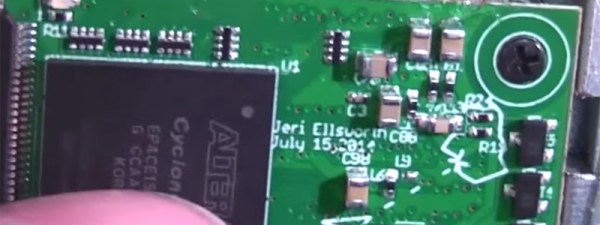[Alan Yates] brought a demo of Valve’s new VR tech that’s the basis of the HTC Vive system to Maker Faire this year. It’s exceptionally clever, and compared to existing VR headsets it’s probably one of the best headtracking solutions out there.
With VR headsets, the problem isn’t putting two displays in front of the user’s eyes. The problem is determining where the user is looking quickly and accurately. IMUs and image processing techniques can be used with varying degrees of success, but to do it right, it needs to be really fast and really cheap.
[Alan] and [Valve]’s ‘Lighthouse’ tracking unit does this by placing a dozen or so IR photodiodes on the headset itself. On the tracking base station, IR lasers scan in the X and Y axes. By scanning these IR lasers across the VR headset, the angle of the headset to the base station can be computed in just a few cycles of a microcontroller. For a bunch of one cent photodiodes, absolute angles and the orientation to a base station can be determined very easily, something that has some pretty incredible applications for everything from VR to robotics.
Remember all of the position tracking hacks that came out as a result of the Nintendo Wii using IR beacons and a tracking camera? This seems like an evolutionary leap forward but in the same realm and can’t wait to see people hacking on this tech!


 The projector itself is the HD25-LV, a 3500 Lumen model from Optima. the HD25-LV is capable of 1080p, though in this situation, brightness is much more important than resolution. [Mikeasaurus] mounted the projector along with a gel cell battery and 900 watt DC to AC inverter to power it. A mobile WiFi hotspot fills out the rooftop kit. Leaving an expensive setup like that on top of a car is a recipe for disaster – be it from rain, rocks, or theft. [Mikeasaurus] thought ahead and strapped his setup down inside a roof mounted cargo box. A plastic covered hole in the front of the box allows the projector to shoot down on the road while protecting its lens. We’d want to add a vent and fan to ensure that projector gets a bit of airflow as well.
The projector itself is the HD25-LV, a 3500 Lumen model from Optima. the HD25-LV is capable of 1080p, though in this situation, brightness is much more important than resolution. [Mikeasaurus] mounted the projector along with a gel cell battery and 900 watt DC to AC inverter to power it. A mobile WiFi hotspot fills out the rooftop kit. Leaving an expensive setup like that on top of a car is a recipe for disaster – be it from rain, rocks, or theft. [Mikeasaurus] thought ahead and strapped his setup down inside a roof mounted cargo box. A plastic covered hole in the front of the box allows the projector to shoot down on the road while protecting its lens. We’d want to add a vent and fan to ensure that projector gets a bit of airflow as well.














